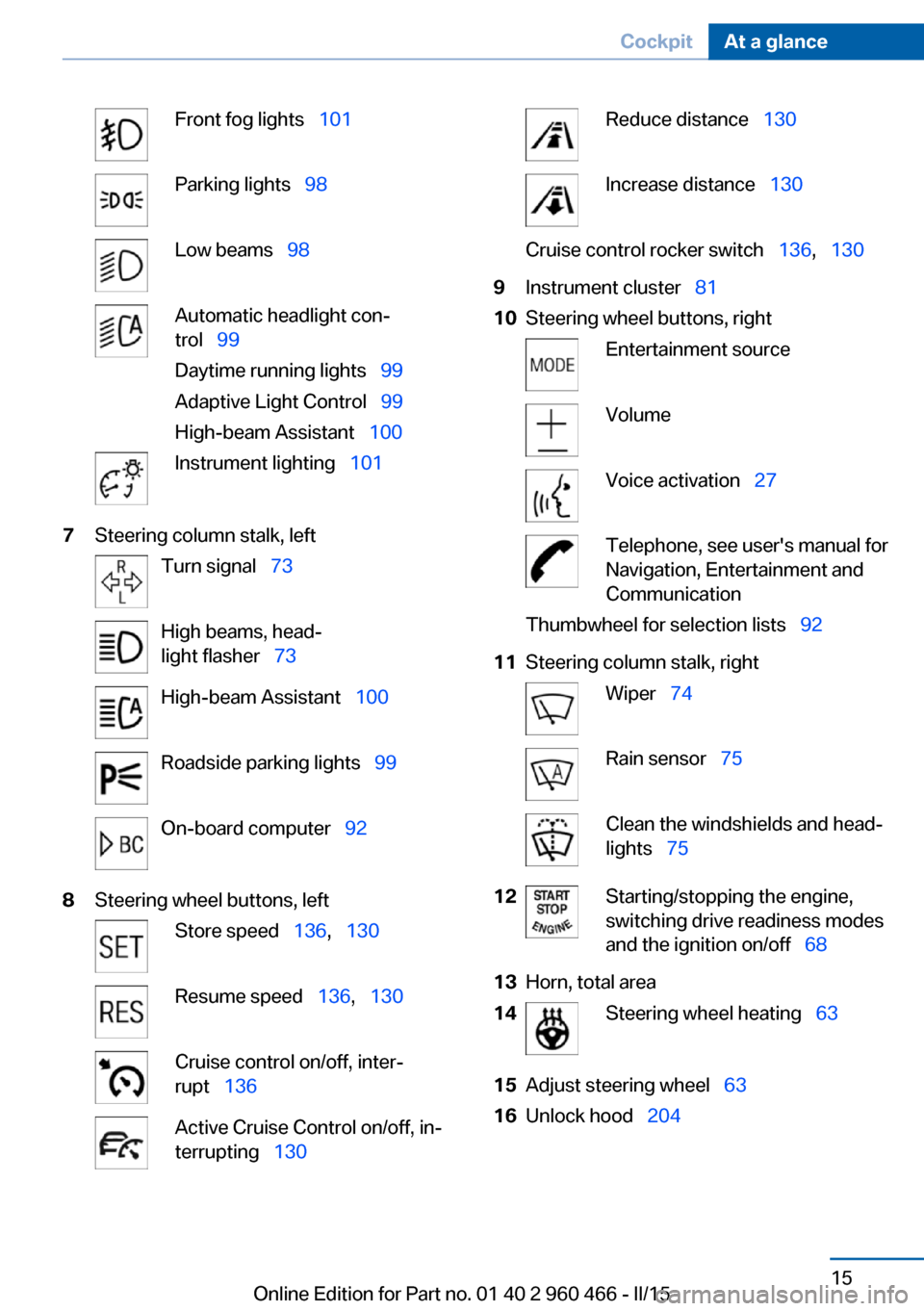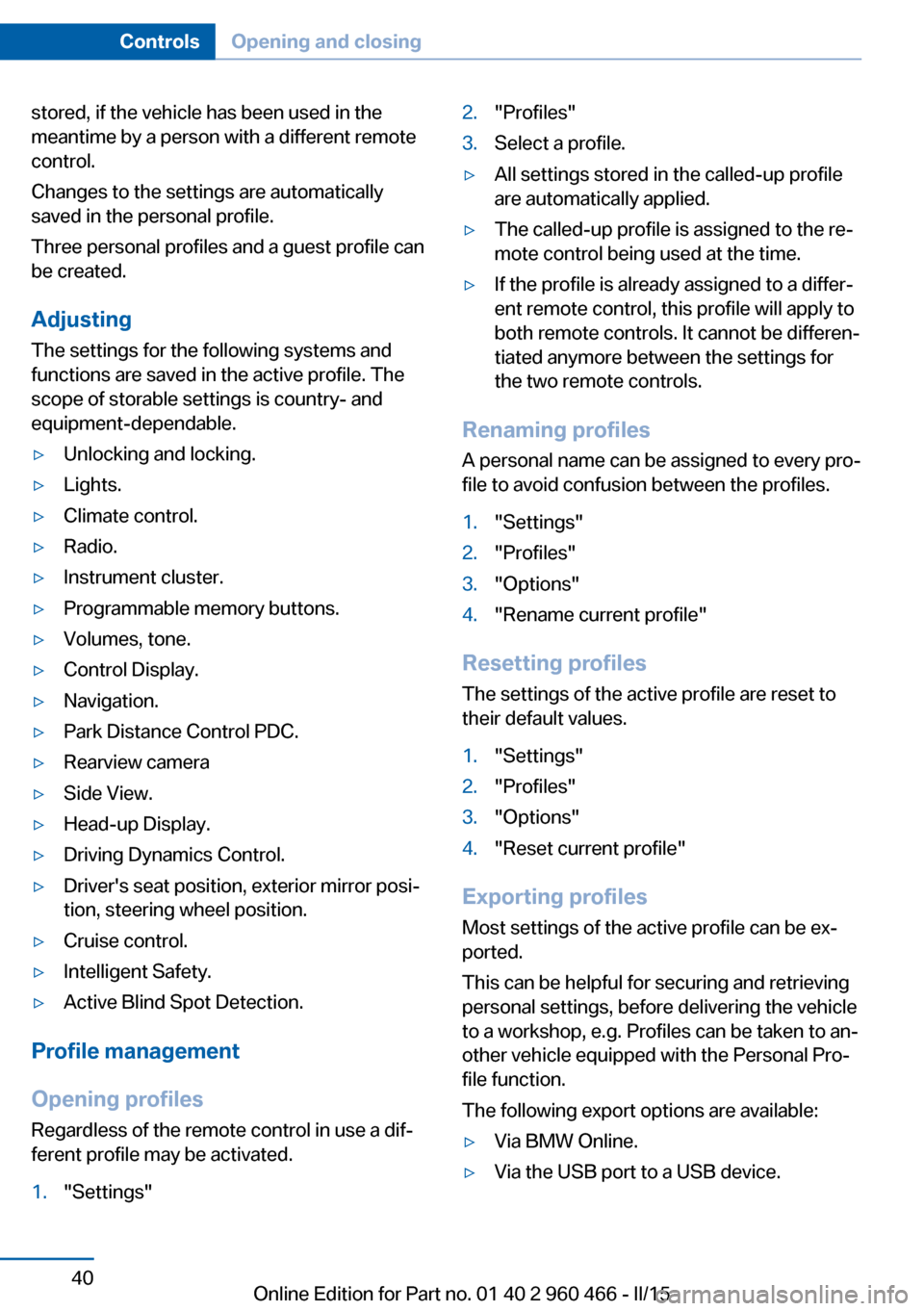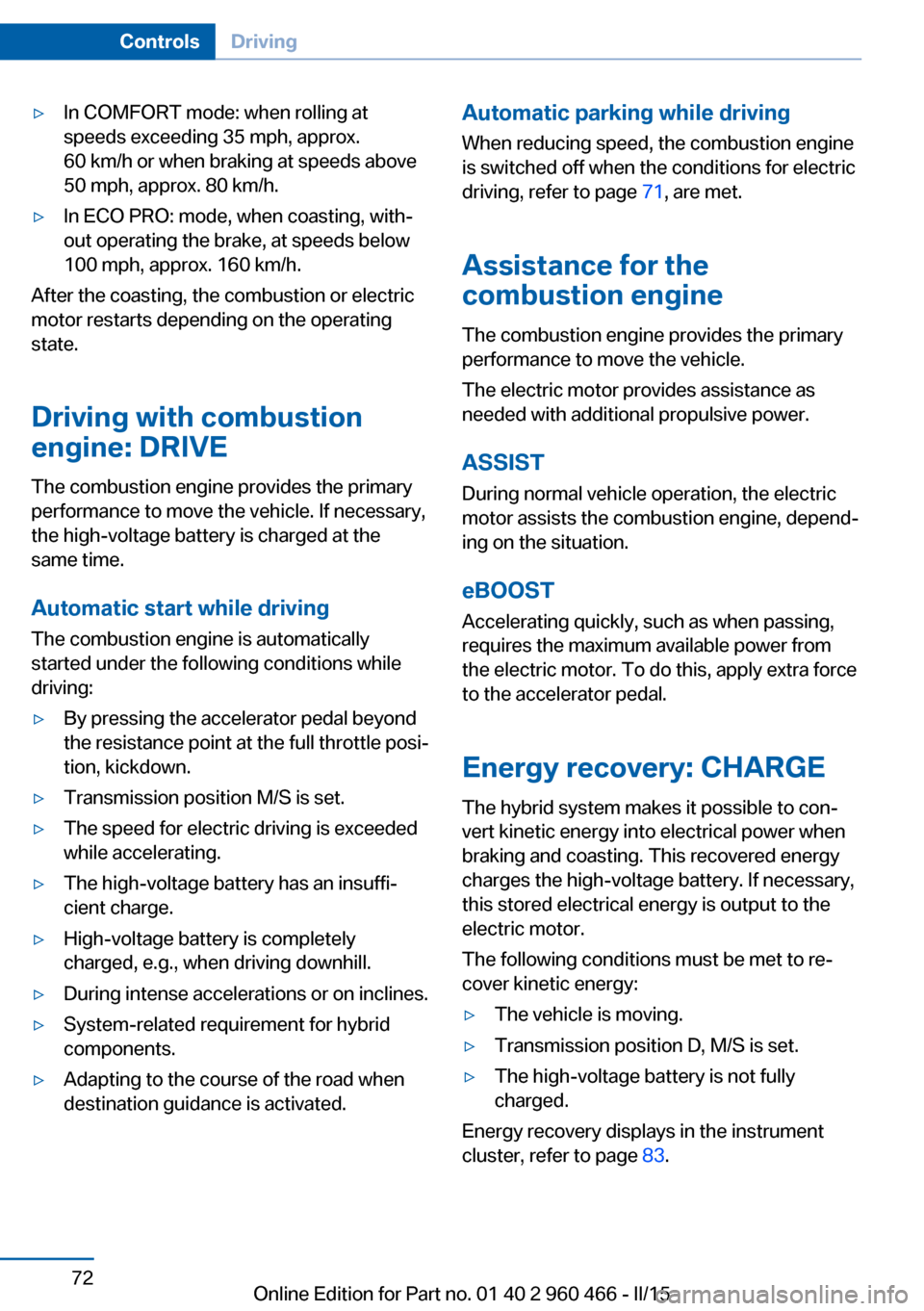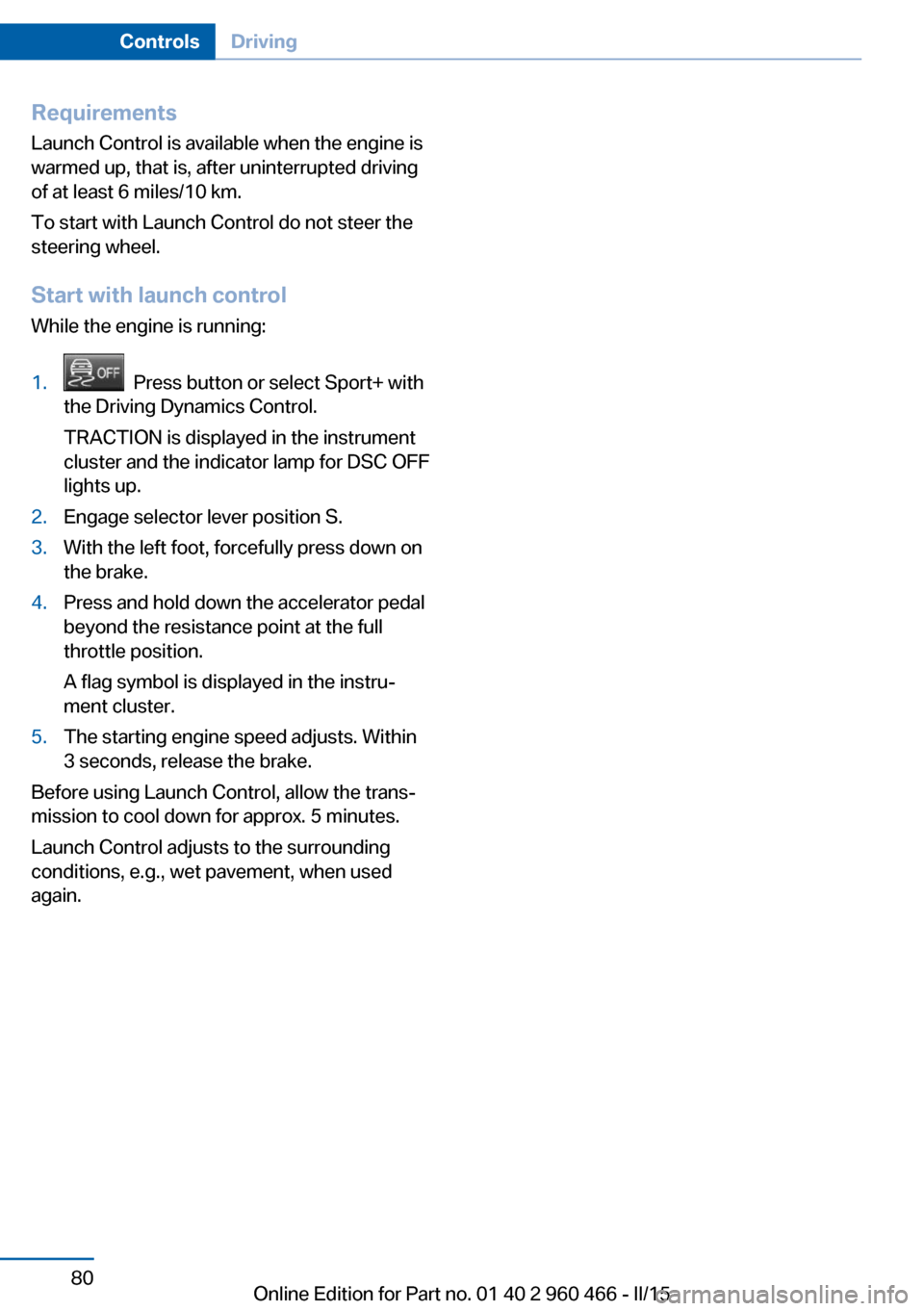instrument cluster BMW ACTIVE HYBRID 3 2015 F30H Owner's Manual
[x] Cancel search | Manufacturer: BMW, Model Year: 2015, Model line: ACTIVE HYBRID 3, Model: BMW ACTIVE HYBRID 3 2015 F30HPages: 251, PDF Size: 5.49 MB
Page 19 of 251

Front fog lights‚Äā‚ÄÖ101Parking lights‚Äā‚ÄÖ98Low beams‚Äā‚ÄÖ98Automatic headlight con‚Äź
trol‚Äā‚ÄÖ 99
Daytime running lights‚Äā‚ÄÖ 99
Adaptive Light Control‚Äā‚ÄÖ 99
High-beam Assistant‚Äā‚ÄÖ 100Instrument lighting‚Äā‚ÄÖ1017Steering column stalk, leftTurn signal‚Äā‚ÄÖ73High beams, head‚Äź
light flasher‚Äā‚ÄÖ 73High-beam Assistant‚Äā‚ÄÖ 100Roadside parking lights‚Äā‚ÄÖ 99On-board computer‚Äā‚ÄÖ928Steering wheel buttons, leftStore speed‚Äā‚ÄÖ136,‚Äā‚ÄÖ130Resume speed‚Äā‚ÄÖ 136,‚Äā‚ÄÖ130Cruise control on/off, inter‚Äź
rupt‚Äā‚ÄÖ 136Active Cruise Control on/off, in‚Äź
terrupting‚Äā‚ÄÖ 130Reduce distance‚Äā‚ÄÖ 130Increase distance‚Äā‚ÄÖ 130Cruise control rocker switch‚Äā‚ÄÖ 136,‚Äā‚ÄÖ1309Instrument cluster‚Äā‚ÄÖ 8110Steering wheel buttons, rightEntertainment sourceVolumeVoice activation‚Äā‚ÄÖ27Telephone, see user's manual for
Navigation, Entertainment and
CommunicationThumbwheel for selection lists‚Äā‚ÄÖ 9211Steering column stalk, rightWiper‚Äā‚ÄÖ74Rain sensor‚Äā‚ÄÖ 75Clean the windshields and head‚Äź
lights‚Äā‚ÄÖ 7512Starting/stopping the engine,
switching drive readiness modes
and the ignition on/off‚Äā‚ÄÖ 6813Horn, total area14Steering wheel heating‚Äā‚ÄÖ 6315Adjust steering wheel‚Äā‚ÄÖ6316Unlock hood‚Äā‚ÄÖ204Seite 15CockpitAt a glance15
Online Edition for Part no. 01 40 2 960 466 - II/15
Page 31 of 251

Voice activation systemVehicle features and options
This chapter describes all standard, country-
specific and optional features offered with the
series. It also describes features that are not
necessarily available in your car, e. g., due to
the selected options or country versions. This
also applies to safety-related functions and
systems. The respectively applicable country
provisions must be observed when using the
respective features and systems.
The concept‚Ė∑Most functions displayed on the Control
Display can be operated by voice com‚Äź
mands via the voice activation system. The
system supports you with announcements
during input.‚Ė∑Functions that can only be used when the
vehicle is stationary cannot be used via the
voice activation system.‚Ė∑The system uses a special microphone on
the driver's side.‚Ė∑‚Äļ...‚ÄĻ Verbal instructions in the Owner's
Manual to use with the voice activation
system.
Requirements
Via the Control Display, set a language that is
also supported by the voice activation system
so that the spoken commands can be identi‚Äź
fied.
Set the language, refer to page 95.
Using voice activation
Activating the voice activation system1. Press button on the steering
wheel.2.Wait for the signal.3.Say the command.
A command that is recognized by the voice
activation system is announced and dis‚Äź
played in the instrument cluster.
This symbol in the instrument cluster indi‚Äź
cates that the voice activation system is active.
If no other commands are available, use func‚Äź
tion via iDrive.
Terminating the voice activation
system
Briefly press the button on the steer‚Äź
ing wheel or ‚ÄļCancel‚ÄĻ.
Possible commands Most menu items on the Control Display can
be voiced as commands.
The available commands depend on the menu
that is currently displayed on the Control Dis‚Äź
play.
There are short commands for many functions.
You may select lists such as phone lists via
voice activation. Read these lists out loud ex‚Äź
actly as they show in the respective list.
Having possible commands read aloud You can have available commands read out
loud for you: ‚ÄļVoice commands‚ÄĻ
E. g. if the "Settings" menu is displayed, the
commands for the settings are read out loud.
Seite 27Voice activation systemAt a glance27
Online Edition for Part no. 01 40 2 960 466 - II/15
Page 44 of 251

stored, if the vehicle has been used in the
meantime by a person with a different remote
control.
Changes to the settings are automatically
saved in the personal profile.
Three personal profiles and a guest profile can
be created.
Adjusting
The settings for the following systems and
functions are saved in the active profile. The
scope of storable settings is country- and
equipment-dependable.‚Ė∑Unlocking and locking.‚Ė∑Lights.‚Ė∑Climate control.‚Ė∑Radio.‚Ė∑Instrument cluster.‚Ė∑Programmable memory buttons.‚Ė∑Volumes, tone.‚Ė∑Control Display.‚Ė∑Navigation.‚Ė∑Park Distance Control PDC.‚Ė∑Rearview camera‚Ė∑Side View.‚Ė∑Head-up Display.‚Ė∑Driving Dynamics Control.‚Ė∑Driver's seat position, exterior mirror posi‚Äź
tion, steering wheel position.‚Ė∑Cruise control.‚Ė∑Intelligent Safety.‚Ė∑Active Blind Spot Detection.
Profile management
Opening profiles Regardless of the remote control in use a dif‚Äź
ferent profile may be activated.
1."Settings"2."Profiles"3.Select a profile.‚Ė∑All settings stored in the called-up profile
are automatically applied.‚Ė∑The called-up profile is assigned to the re‚Äź
mote control being used at the time.‚Ė∑If the profile is already assigned to a differ‚Äź
ent remote control, this profile will apply to
both remote controls. It cannot be differen‚Äź
tiated anymore between the settings for
the two remote controls.
Renaming profiles
A personal name can be assigned to every pro‚Äź
file to avoid confusion between the profiles.
1."Settings"2."Profiles"3."Options"4."Rename current profile"
Resetting profiles
The settings of the active profile are reset to
their default values.
1."Settings"2."Profiles"3."Options"4."Reset current profile"
Exporting profiles
Most settings of the active profile can be ex‚Äź
ported.
This can be helpful for securing and retrieving
personal settings, before delivering the vehicle
to a workshop, e.g. Profiles can be taken to an‚Äź
other vehicle equipped with the Personal Pro‚Äź
file function.
The following export options are available:
‚Ė∑Via BMW Online.‚Ė∑Via the USB port to a USB device.Seite 40ControlsOpening and closing40
Online Edition for Part no. 01 40 2 960 466 - II/15
Page 72 of 251

DrivingVehicle features and options
This chapter describes all standard, country-
specific and optional features offered with the
series. It also describes features that are not
necessarily available in your car, e. g., due to
the selected options or country versions. This
also applies to safety-related functions and
systems. The respectively applicable country
provisions must be observed when using the
respective features and systems.
Start/Stop button, drive readiness
The concept The following ready states can
be attained by pressing the
Start/Stop button:‚Ė∑Radio ready state on/off.‚Ė∑Ignition on/off.‚Ė∑Activating/deactivating drive readiness.
To activate drive readiness, press the brake
pedal.
Switching radio-ready state on/off
The radio-ready state is activated by pressing
the Start/Stop button in the following situa‚Äź
tions:
‚Ė∑When the engine is running.‚Ė∑When drive readiness is activated.‚Ė∑When the engine is switched off automati‚Äź
cally using the Auto Start/Stop function
and the brake is not applied.
Some electronic systems/power consumers
remain ready for operation.
Radio ready state is switched off automatically:
‚Ė∑After approx. 8 minutes.‚Ė∑When the vehicle is locked using the cen‚Äź
tral locking system.‚Ė∑Shortly before the battery is discharged
completely, so that the engine can still be
started.
If the engine is switched off and the ignition is
switched on, the system automatically
switches to the radio-ready state if the lights
are turned off or, if correspondingly equipped,
the daytime running lights are activated.
Ignition on Press the Start/Stop button, and do not press
on the brake pedal at the same time.
All vehicle systems are ready for operation.
Most of the indicator and warning lights in the
instrument cluster light up for a varied length
of time.
To save battery power when the engine is off,
switch off the ignition and any unnecessary
electronic systems/power consumers.
Ignition offPress the Start/Stop button again without
stepping on the brake.
All indicator lights in the instrument cluster go
out.
To save battery power when the engine is off,
switch off the ignition and any unnecessary
electronic systems/power consumers.
P when the ignition is switched off
P is engaged automatically when the ig‚Äź
nition is switched off. When in an automatic car
wash, e.g., ensure that the ignition is not
switched off accidentally.‚óÄ
The ignition is switched off automatically in the
following situations while the vehicle is station‚Äź
ary and the engine is off:
Seite 68ControlsDriving68
Online Edition for Part no. 01 40 2 960 466 - II/15
Page 76 of 251

‚Ė∑In COMFORT mode: when rolling at
speeds exceeding 35 mph, approx.
60 km/h or when braking at speeds above
50 mph, approx. 80 km/h.‚Ė∑In ECO PRO: mode, when coasting, with‚Äź
out operating the brake, at speeds below
100 mph, approx. 160 km/h.
After the coasting, the combustion or electric
motor restarts depending on the operating
state.
Driving with combustion
engine: DRIVE
The combustion engine provides the primary
performance to move the vehicle. If necessary,
the high-voltage battery is charged at the
same time.
Automatic start while driving The combustion engine is automatically
started under the following conditions while
driving:
‚Ė∑By pressing the accelerator pedal beyond
the resistance point at the full throttle posi‚Äź
tion, kickdown.‚Ė∑Transmission position M/S is set.‚Ė∑The speed for electric driving is exceeded
while accelerating.‚Ė∑The high-voltage battery has an insuffi‚Äź
cient charge.‚Ė∑High-voltage battery is completely
charged, e.g., when driving downhill.‚Ė∑During intense accelerations or on inclines.‚Ė∑System-related requirement for hybrid
components.‚Ė∑Adapting to the course of the road when
destination guidance is activated.Automatic parking while driving
When reducing speed, the combustion engine
is switched off when the conditions for electric
driving, refer to page 71, are met.
Assistance for the
combustion engine
The combustion engine provides the primary
performance to move the vehicle.
The electric motor provides assistance as
needed with additional propulsive power.
ASSIST
During normal vehicle operation, the electric
motor assists the combustion engine, depend‚Äź
ing on the situation.
eBOOST
Accelerating quickly, such as when passing,
requires the maximum available power from
the electric motor. To do this, apply extra force
to the accelerator pedal.
Energy recovery: CHARGEThe hybrid system makes it possible to con‚Äź
vert kinetic energy into electrical power when
braking and coasting. This recovered energy
charges the high-voltage battery. If necessary,
this stored electrical energy is output to the
electric motor.
The following conditions must be met to re‚Äź
cover kinetic energy:‚Ė∑The vehicle is moving.‚Ė∑Transmission position D, M/S is set.‚Ė∑The high-voltage battery is not fully
charged.
Energy recovery displays in the instrument
cluster, refer to page 83.
Seite 72ControlsDriving72
Online Edition for Part no. 01 40 2 960 466 - II/15
Page 82 of 251

Sport program and manual mode
Activating the sport program
Press the selector lever to the left out of selec‚Äź
tor lever position D.
The sport program of the transmission is acti‚Äź
vated.
eDRIVE electric driving and the Auto Start
Stop function are deactivated. Coasting to a
standstill and braking phases will be used
more often to recover energy. The high-volt‚Äź
age battery will be charged more quickly.
Activating the M/S manual mode
1.Press the selector lever to the left out of
selector lever position D.2.Push the selector lever forward or pull it
backward.
Manual mode becomes active and the gear is
changed.
The engaged gear is displayed in the instru‚Äź
ment cluster, e.g., M1.
Once maximum engine speed is attained, M/S
manual mode is automatically upshifted as
needed.
Switching to manual mode
‚Ė∑To shift down: press the selector lever for‚Äź
ward.‚Ė∑To shift up: pull the selector lever rear‚Äź
wards.Gears will only be shifted at appropriate engine
and road speeds, for example downshifting is
not possible if the engine speed is too high.
The selected gear is briefly displayed in the in‚Äź
strument cluster, followed by the currently se‚Äź
lected gear.
Steptronic Sport transmission:
prevent automatic upshifting in M/S
manual mode
The Steptronic Sport transmission does not
automatically upshift in M/S manual mode
once the maximum speed is reached, if one of
the following conditions is met:‚Ė∑DSC deactivated.‚Ė∑TRACTION activated.‚Ė∑SPORT+ activated.
In addition, the kickdown is deactivated.
With the respective transmission version, the
lowest possible gear can be selected by simul‚Äź
taneously operating the kickdown and the left
shift paddle. However, this effect is not pro‚Äź
duced via the shift paddles when switching
briefly from D to manual mode.
Ending the sport program/manual
mode
Push the selector lever to the right.
D is displayed in the instrument cluster.
Shift paddles
The shift paddles on the steering wheel allow
you to shift gears quickly while keeping both
hands on the steering wheel.
Seite 78ControlsDriving78
Online Edition for Part no. 01 40 2 960 466 - II/15
Page 83 of 251

‚Ė∑Shift up: briefly pull right shift paddle.‚Ė∑Shift down: briefly pull left shift paddle.‚Ė∑With the respective transmission version,
the lowest possible gear can be selected
by pulling and holding the left shift paddle.
Gears will only be shifted at appropriate engine
and road speeds, for example downshifting is
not possible if the engine speed is too high.
The selected gear is briefly displayed in the in‚Äź
strument cluster, followed by the current gear.
If the shift paddles on the steering wheel are
used to shift gears in automatic mode, the
transmission temporarily switches to manual
mode.
If the selector lever is still in selector lever po‚Äź
sition D with the respective transmission ver‚Äź
sion, it is possible to switch back into the auto‚Äź
matic mode:
‚Ė∑Pull and hold right shift paddle.
Or‚Ė∑In addition to the briefly pulled right shift
paddle, briefly pull the left shift paddle.
In the manual mode, after conservative driving
for a certain amount of time or if there has
been no acceleration or shifting of the shift
paddles within a certain amount of time, the
transmission switches back to automatic
mode.
Displays in the instrument cluster The selector lever position is dis‚Äź
played, e.g.: P.
Electronic unlocking of the
transmission lock
General information
Electronically unlock the transmission lock to
maneuver vehicle from the danger area.
Unlocking is possible, if the started can spin
the engine.
Engaging selector lever position N1.Depress the brake pedal.2.Press the Start/Stop button. The starter
must audibly start.3.Press and hold the selector lever into posi‚Äź
tion N.
A corresponding Check Control message
is displayed.4.Press the selector lever again into posi‚Äź
tion N within approx. 6 seconds.
Position N is displayed in the instrument
cluster.5.Release brake, as soon as the starter
stops.6.Maneuver the vehicle from the danger area
and secure it against moving on its own.
Steptronic Sport transmission:
Launch Control
The concept Launch Control enables optimum accelerationon surfaces with good traction.
Hints Component wear
Do not use Launch Control too often;
otherwise, this may result in premature wear of
components due to the high stress placed on
the vehicle.‚óÄ
Do not use Launch Control during the break-in,
refer to page 172, period.
To increase vehicle stability, activate DSC
again as soon as possible.
An experienced driver may be able to achieve
better acceleration values in DSC OFF mode.
Seite 79DrivingControls79
Online Edition for Part no. 01 40 2 960 466 - II/15
Page 84 of 251

RequirementsLaunch Control is available when the engine is
warmed up, that is, after uninterrupted driving
of at least 6 miles/10 km.
To start with Launch Control do not steer the
steering wheel.
Start with launch control While the engine is running:1. Press button or select Sport+ with
the Driving Dynamics Control.
TRACTION is displayed in the instrument
cluster and the indicator lamp for DSC OFF
lights up.2.Engage selector lever position S.3.With the left foot, forcefully press down on
the brake.4.Press and hold down the accelerator pedal
beyond the resistance point at the full
throttle position.
A flag symbol is displayed in the instru‚Äź
ment cluster.5.The starting engine speed adjusts. Within
3 seconds, release the brake.
Before using Launch Control, allow the trans‚Äź
mission to cool down for approx. 5 minutes.
Launch Control adjusts to the surrounding
conditions, e.g., wet pavement, when used
again.
Seite 80ControlsDriving80
Online Edition for Part no. 01 40 2 960 466 - II/15
Page 85 of 251

DisplaysVehicle features and optionsThis chapter describes all standard, country-
specific and optional features offered with the
series. It also describes features that are not
necessarily available in your car, e. g., due tothe selected options or country versions. This
also applies to safety-related functions and
systems. The respectively applicable country
provisions must be observed when using the
respective features and systems.
Overview, instrument cluster
1Fuel gauge‚Äā‚ÄÖ 882Speedometer3Messages, e.g. Check Control4Tachometer‚Äā‚ÄÖ 885Engine oil temperature‚Äā‚ÄÖ 886Current fuel consumption7Electronic displays‚Äā‚ÄÖ818Reset miles‚Äā‚ÄÖ88
Electronic displays
‚Ė∑Displays of the hybrid system, refer to
page 82.‚Ė∑Selection lists, refer to page 92.‚Ė∑External temperature, refer to page 88.‚Ė∑Auto Start/Stop function, refer to page 70.‚Ė∑On-board computer, refer to page 92.‚Ė∑Date, refer to page 89.‚Ė∑Transmission display, refer to page 79.Seite 81DisplaysControls81
Online Edition for Part no. 01 40 2 960 466 - II/15
Page 86 of 251

‚Ė∑Miles/trip miles, refer to page 88.‚Ė∑Messages, e.g. Check Control, refer to
page 84.‚Ė∑Current fuel consumption, refer to
page 89.‚Ė∑Navigation display, see User's manual for
Navigation, Entertainment and Communi‚Äź
cation.‚Ė∑Range, refer to page 89.‚Ė∑Status, Driving Dynamics Control, refer to
page 127.‚Ė∑Service requirements, refer to page 89.‚Ė∑Speed limit detection, refer to page 90.‚Ė∑Time, refer to page 88.
Displays of the hybrid
system
Displays in the instrument cluster
The concept The following functions of the hybrid system
are displayed:
‚Ė∑High-voltage battery charge indicator, refer
to page 82.‚Ė∑Electric driving: eDRIVE.‚Ė∑Acceleration boost: eBOOST, refer to
page 83.‚Ė∑Energy recovery: CHARGE, refer to
page 83.‚Ė∑Drive readiness: READY, refer to
page 82.
The display depends on the system's operat‚Äź
ing condition.
Note High voltage
Even if no bars are displayed in the bat‚Äź
tery symbol, the high-voltage system is still under high voltage.‚óÄ
High-voltage battery charge indicator
When drive readiness is switched on in COM‚Äź
FORT mode, displays the available charge of
the high-voltage battery with bars in a battery
symbol. If five bars are shown, the high-voltage
battery is fully charged.
During normal vehicle operation, the high-volt‚Äź
age battery is charged up to approx. 80 %.
This ensures optimum energy recovery when
braking or driving downhill.
Drive readiness: READY READY indicates drive readi‚Äź
ness. For further information,
please refer to Drive readiness
in detail, refer to page 69.
Electric driving: eDRIVE
When driving in COMFORT or ECO PRO
modes, the power output of the electric motor
is indicated by arrows on the instrument clus‚Äź
ter.
Depending on the position of the accelerator
pedal, up to four arrows are displayed simulta‚Äź
Seite 82ControlsDisplays82
Online Edition for Part no. 01 40 2 960 466 - II/15